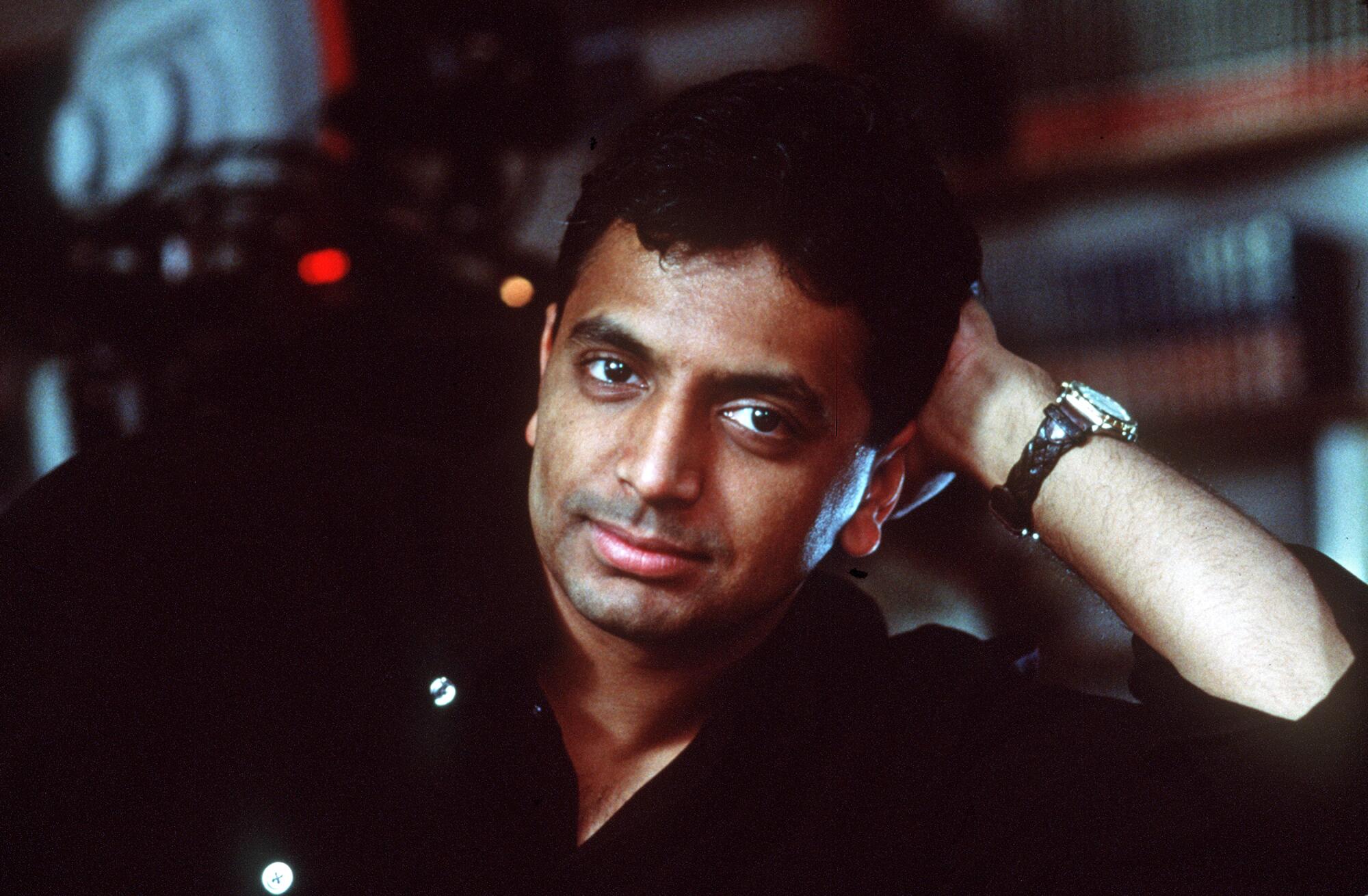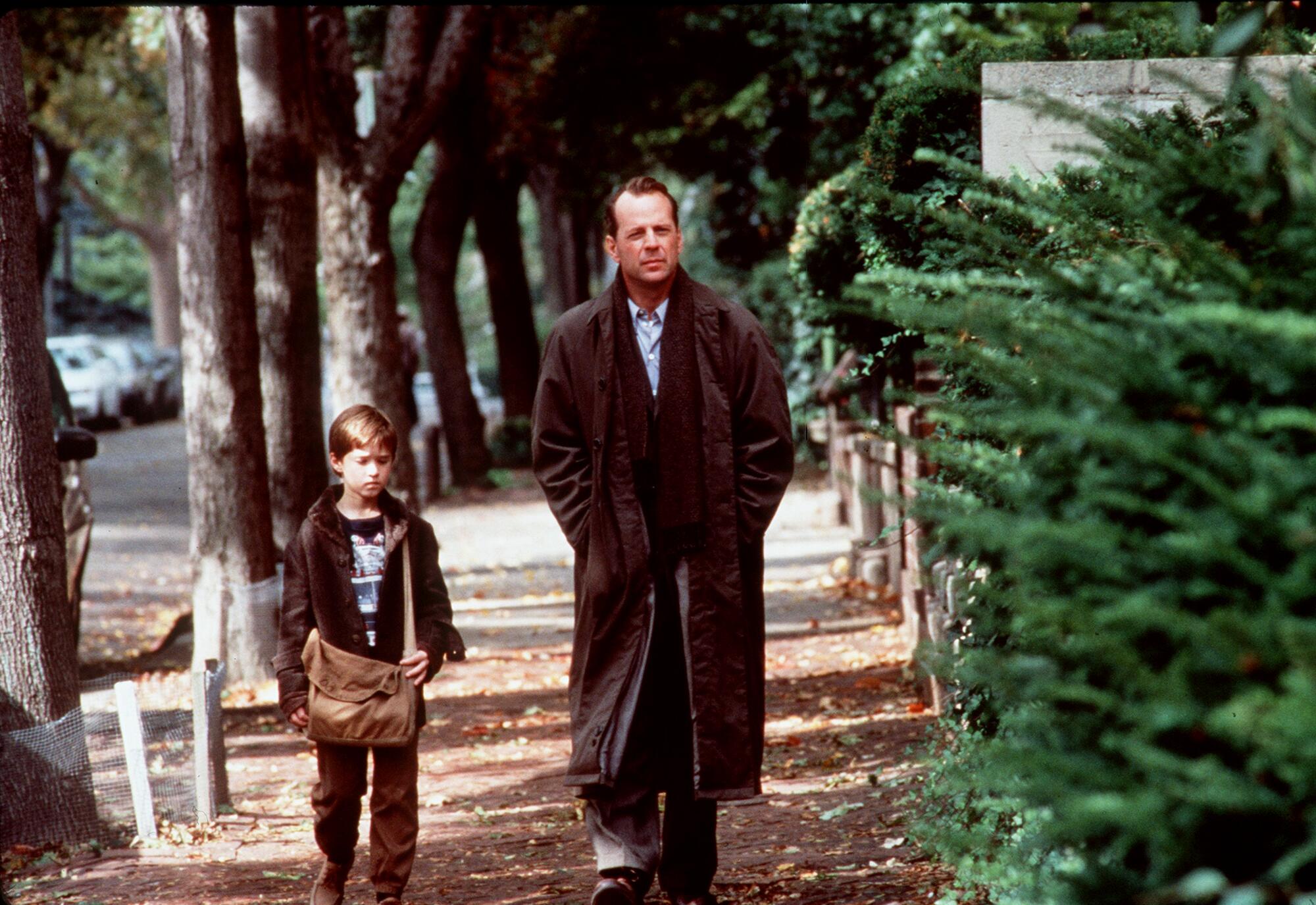(Spoiler alert: If you’ve somehow never seen “The Sixth Sense,” please refrain from reading this article.)
About midway through “The Sixth Sense,” Bruce Willis’ Malcolm, a compassionate child psychologist, attempts to cheer up Haley Joel Osment’s Cole, a disturbed boy struggling with secrets he’s too scared to reveal. Malcolm tries telling Cole a bedtime story, but it’s meandering and uninteresting — finally, the 9-year-old takes over, offering some pointers on how to craft an arresting tale. “You have to add some twists and stuff,” he says.
Writer-director M. Night Shyamalan clearly heeded his character’s advice. It’s been 25 years to the day since his unlikely blockbuster was released, becoming one of 1999’s biggest hits on its way to earning six Academy Award nominations, including best picture (rare for a horror movie). But arguably the film’s most lasting impact — even more so than Cole’s endlessly quoted “I see dead people” — was introducing the modern moviegoer to the complicated beauty of the perfectly executed third-act twist. There were, of course, memorable twists in cinema before “The Sixth Sense” — for instance, in the Charlton Heston chestnuts “Planet of the Apes” and “Soylent Green” — but what Shyamalan achieved haunted his future movies, his career in general and our ability to enjoy such late-reel surprises in other people’s films. The Twist grabbed us and never let go.

The 1999 Project
All year we’ll be marking the 25th anniversary of pop culture milestones that remade the world as we knew it then and created the world we live in now. Welcome to The 1999 Project, from the Los Angeles Times.
Many remember the first time they saw “The Sixth Sense,” but only a lucky few read the screenplay as a spec script back in September 1997, when it was scooped up for a reported $2.25 million by Hollywood Pictures — it was a time when high-concept original ideas, such as “Basic Instinct,” frequently sold for seven figures. Even before Hollywood development executives had the spec in their hands, the buzz was intense, despite no one really knowing what the story was about.
“That is probably the only spec script where I actually remember the circumstances of it,” recalls Anne Helmstadter, who was then vice president of Maysville Pictures, a production company run by producer Robert Lawrence and the “ER”-era George Clooney. (Full disclosure: Helmstadter was my boss at the time.) In the late 1990s, agents habitually sent companies a couple spec scripts a day, and most of them were atrocious.

M. Night Shyamalan on the set of “The Sixth Sense.”
(Ron Phillips / Touchstone Pictures)
But the industry chatter was that “The Sixth Sense” was different. “I remember that the terms [from the agent] were ‘It’s coming to you and you have to read it right away,’” Helmstadter says. Like most of Hollywood, she dove into the script immediately in anticipation of a fierce bidding war between studios to acquire the project. Did she see the Twist coming? “I do remember thinking, ‘Something’s going to happen — what is it?’ But I didn’t foresee it.”
Aditya Sood, 48, who in 1997 was just starting in the business as an assistant at Mark Johnson Productions, was tasked with picking up the approximately 120-page spec directly from United Talent Agency. “I think I was probably 60 pages in by the time I got back to the office,” Sood, now president of Lord Miller Productions, the company behind the Oscar-winning “Spider-Verse” pictures, tells me. “I remember getting to Page 119 and going, ‘Wow, this is one of the most incredible scripts I’ve ever read.’ And then, literally, I turned the page. It was such a good script even before you got to the reveal — and then the reveal just blew your mind.”
It would go on to blow audiences’ minds as well — well, most people’s. Everybody has that one friend who likes to brag that they saw “The Sixth Sense’s” twist coming a mile away, that it was so obvious that Malcolm had been, unbeknownst to himself, dead the whole time. Well, good for them. Such is the film’s power that contrarians felt compelled to dispute its greatness by asserting their superiority.
But it almost didn’t matter whether the Twist worked for you. What mattered is that it was audacious in a way few films attempted to be. Previous twists were built around discoveries made by the main characters about the worlds around them. But in “The Sixth Sense,” Malcolm learns something profound about himself — he is so consumed with compensating for having failed a suicidal former patient, he never realized that he’d been fatally shot. On its simplest level, Shyamalan’s breakthrough film was about people’s tendency to prioritize work over loved ones — about being so wrapped up in the things you think you’re “supposed” to be doing that you lose track of what’s important. Like Malcolm, our concern for saving Cole distracted us from the awful truth. The Twist was stunning because, like Malcolm, we never saw it coming.
Audiences have a love-hate relationship with twists. Short story writers like O. Henry dazzled readers with their deft finales. “The Twilight Zone” frequently featured episodes that ended with a shock. We adore the pleasure, akin to riding a roller coaster, of being jerked around efficiently. As Helmstadter, the founder of the Story Immersion Project, a site that coaches burgeoning writers, describes the finish of “The Sixth Sense,” it’s “that wonderful, surprising, yet inevitable ending where you’re like, ‘Oh, of course, it all makes sense.’”
And yet, there’s also a feeling of betrayal that comes with a twist ending, an irritation that the filmmaker hasn’t played fair, no matter how seamless the logic. Inherently, any twist ending is a violation of our tacit agreement with a movie — we thought the film was playing straight with us, and then at the last moment, we discover we’ve been duped. Only the best twists don’t feel like cheap tricks, their narrative mechanics so retroactively airtight that you don’t resent being cheated. That’s why “The Sixth Sense” remains so popular: Maybe the occasional scene between Malcolm and his oddly distant wife Anna (Olivia Williams) is, in hindsight, awkwardly staged, but otherwise Malcolm’s blinkered worldview holds up ingeniously on repeat viewings.
Shyamalan benefited from audiences having no idea who he was. In 1997, when he sold “The Sixth Sense,” he’d directed only the little-seen 1992 indie drama “Praying With Anger,” which he starred in. (His family film “Wide Awake” — which, by the way, also contained a twist ending — wouldn’t arrive until 1998, a year before “The Sixth Sense.”) So there was little warning that the budding auteur, who turned 29 the day his magnum opus opened, would knock us sideways.
But like a movie star closely associated with an iconic role he’ll never quite shake, Shyamalan would come to be defined by the Twist, especially because he kept chasing after equally expert twist endings in his subsequent films. But diminishing returns inevitably kicked in, even in those rare cases when the twist was compelling. “I remember someone slipping me the ‘Unbreakable’ script,” Sood says, referring to Shyamalan’s follow-up film. “It was a totally different experience because we were waiting for the twist.”

Haley Joel Osment, left, and Bruce Willis in the movie “The Sixth Sense.”
(Ron Phillips / Touchstone Pictures)
Part of what made “The Sixth Sense’s” ending indelible was we had not been on high alert for its possibility. But such a blindside can be executed only once, and so what had been emotionally affecting about “The Sixth Sense” swiftly became a gimmick — or, in the case of Shyamalan’s much-derided 2004 film “The Village,” validation for those who thought the director was a one-trick pony. Artistry was no longer the criterion to measure his work. The only question was, “How good was the twist?”
If it’s any consolation, few other filmmakers have had much luck with a great twist ending during the last 25 years, either. With rare exceptions, like “Fight Club,” “The Others” and “Shutter Island” (films whose final reveals, like that of “The Sixth Sense,” speak to something tragic about their protagonists), most were mocked for their ludicrousness. In 2019, Paul Feig’s “Last Christmas” focused on a love story between Emilia Clarke and Henry Golding, in which — as everyone who saw the movie correctly guessed — Golding was actually dead. Even last year’s moving “All of Us Strangers” was slightly diminished for me because, about halfway through, I noticed that whenever Andrew Scott hung out with the too-good-to-be-alive Paul Mescal, no one else ever interacted with them. (In a Vulture explainer about the “All of Us Strangers” twist ending, writer Zing Tsjeng cheekily floated the theory that Scott’s character was Osment’s Cole all grown up.) We had learned to be on the lookout for the telltale signs. Unconsciously, Shyamalan had conditioned us never to let our guard down.
He will never escape his movie’s most enduring legacy. With each new Shyamalan film, publications re-rank his twist endings. In a 2019 interview, the New York Times asked him to name the biggest plot twist in his own life. In a sense, he’s trapped: When his movies have a twist, we compare it unfavorably with the one in “The Sixth Sense,” and if they don’t have a twist, we feel weirdly let down.
Last year, Shyamalan was asked about the criticism regarding his penchant for twists, to which he responded, “I don’t think about it. If I was being critical about criticism, their track record in art has not been the greatest.” It was a pithy, defensive reply, an indication that he probably does think about it. To Shyamalan’s mind, he operates in the world of thrillers and mysteries, genres that often come bearing unexpected resolutions. But his dependence on the gotcha has marred his filmography, leaving the filmmaker with a spotty track record himself.
A quarter century later, M. Night Shyamalan has enjoyed a career of ups and downs, hits and flops, twists that worked and twists that most assuredly didn’t. His latest film, “Trap,” which features a mediocre finale, underperformed on its opening weekend, its profitability far from a sure thing. Fairly or not, he’ll always be punished for pulling off one of the hardest things in storytelling — and then daring to repeat it. Sticking the landing is difficult enough — to create an ending that floors viewers, forcing us to rethink everything we’ve just seen, is nigh impossible. Maybe if he’d stop pursuing such endings, we would have forgiven him by now.
Shyamalan’s poignant, remarkable twist was a kind of magic — “Some magic’s real,” Cole tells Malcolm, again with a wisdom beyond his years — but what makes magic so captivating is that it feels special. It’s not meant to be endlessly replicated.


